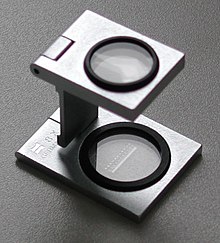Thread counter
A thread counter or Weber glass is a simple version of a measuring magnifier with a three to twelve times magnification on a (usually foldable) frame to achieve a fixed working distance. This distance depends on the magnification and the focal length of the magnifying glass.
construction
A thread counter is usually made of three metal or plastic surfaces that are hingedly connected to one another by means of two hinges . The height of the middle support surface also defines the dimension for the working distance. Set up ready for use, there is a mostly circular opening in the upper surface as a holder for the detail magnifying glass ; when folded , it lies between the other two and is thus protected during transport. The magnifying glass usually only consists of a single lens. Lens combinations such as achromatic or aplanate are rare.
The base plate has regular square openings. The edge lengths of this opening are usually 10 × 10 mm, or 1 "× 1" ( inch = 25.4 mm). Other dimensions are also used.
use
The thread counter was invented to check fabrics . In the textile industry, it counts the number of warp and weft threads within a certain area. In the carpet trade, thread counters can be used to determine the number of knots per surface of knotted carpets.
Thread counters are also used in other industries :
In the printing and publishing industry in prepress often for evaluating print templates , on the printing press for screen and register control .
In the graphic design industry and geography thread counter were the computer-based before the introduction of desktop publishing (DTP) until about the middle of the 1980s, to assess the accuracy of manually by means of ink and rulers on special cardboard -made final drawings used.
Also in the production of printed circuit boards and in the production of printed circuit board assemblies , the thread counter is used as a simple enlargement and test instrument.
Problems with defective users
Users with ametropia, especially those with farsightedness or presbyopia , often do not see the object to be viewed clearly enough. Since the distance between the magnifying glass and the object cannot be changed due to the design, there is a problem here.
Special designs
In addition to special sizes of the foot opening, which are dependent on the application, thread counters with a graticule and an engraved scale are also used. Thread counters with graticules are a “transition” to the measuring magnifier, which usually cannot be folded down and on which the magnifier (often lens systems as achromatic or aplanat , recently also aspherical lenses ) is guided in a tube . This guidance allows adaptation to the user's individual ametropia.
literature
- Edward Bausch: Manipulation of the Microscope . ISBN 978-1-103-41317-1 , pp. 19 ( limited preview in Google Book search).
Individual evidence
- ^ Otto Lueger: Lexicon of the entire technology and its auxiliary sciences. Volume 8, Stuttgart / Leipzig 1910, p. 887.


